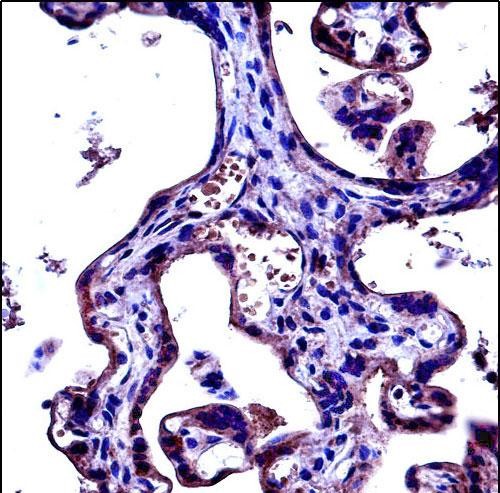CD97 Antibody (C-term)
Affinity Purified Rabbit Polyclonal Antibody (Pab)
- SPECIFICATION
- CITATIONS
- PROTOCOLS
- BACKGROUND

Application
| IHC-P, WB, E |
|---|---|
| Primary Accession | P48960 |
| Other Accession | NP_001775.2, NP_510966.1, NP_001020331.1 |
| Reactivity | Human |
| Host | Rabbit |
| Clonality | Polyclonal |
| Isotype | Rabbit IgG |
| Calculated MW | 91869 Da |
| Antigen Region | 707-736 aa |
| Gene ID | 976 |
|---|---|
| Other Names | CD97 antigen, Leukocyte antigen CD97, CD97, CD97 antigen subunit alpha, CD97 antigen subunit beta, CD97 |
| Target/Specificity | This CD97 antibody is generated from rabbits immunized with a KLH conjugated synthetic peptide between 707-736 amino acids from the C-terminal region of human CD97. |
| Dilution | IHC-P~~1:10~50 WB~~1:1000 E~~Use at an assay dependent concentration. |
| Format | Purified polyclonal antibody supplied in PBS with 0.09% (W/V) sodium azide. This antibody is purified through a protein A column, followed by peptide affinity purification. |
| Storage | Maintain refrigerated at 2-8°C for up to 2 weeks. For long term storage store at -20°C in small aliquots to prevent freeze-thaw cycles. |
| Precautions | CD97 Antibody (C-term) is for research use only and not for use in diagnostic or therapeutic procedures. |
| Name | ADGRE5 (HGNC:1711) |
|---|---|
| Function | Receptor potentially involved in both adhesion and signaling processes early after leukocyte activation. Plays an essential role in leukocyte migration. |
| Cellular Location | Cell membrane {ECO:0000250|UniProtKB:Q9Z0M6}; Multi-pass membrane protein |
| Tissue Location | Broadly expressed, found on most hematopoietic cells, including activated lymphocytes, monocytes, macrophages, dendritic cells, and granulocytes. Expressed also abundantly by smooth muscle cells. Expressed in thyroid, colorectal, gastric, esophageal and pancreatic carcinomas too. Expression are increased under inflammatory conditions in the CNS of multiple sclerosis and in synovial tissue of patients with rheumatoid arthritis. Increased expression of CD97 in the synovium is accompanied by detectable levels of soluble CD97 in the synovial fluid |

Thousands of laboratories across the world have published research that depended on the performance of antibodies from Abcepta to advance their research. Check out links to articles that cite our products in major peer-reviewed journals, organized by research category.
info@abcepta.com, and receive a free "I Love Antibodies" mug.
Provided below are standard protocols that you may find useful for product applications.
Background
This gene is a member of the EGF-TM7 family of class II seven-span transmembrane (7-TM) molecules, likely encoded by a gene cluster on the short arm of chromosome 19. The encoded product is a glycoprotein that is present on the surface of most activated leukocytes and spans the membrane seven times, which is a defining feature of G protein-coupled receptors. The protein has an extended extracellular region with several N-terminal epidermal growth factor (EGF)-like domains, which mediate binding to its cellular ligand, decay accelerating factor (DAF, CD55), a regulatory protein of the complement cascade. The presence of structural features characteristic of extracellular matrix proteins and transmembrane proteins suggests that this protein is a receptor involved in both cell adhesion and signaling processes early after leukocyte activation. Alternative splicing has been observed for this gene and three variants have been found.
References
Bailey, S.D., et al. Diabetes Care 33(10):2250-2253(2010)
Liu, D., et al. Int. J. Oncol. 36(6):1401-1408(2010)
Han, S.L., et al. Int J Colorectal Dis 25(6):695-702(2010)
van Eijk, M., et al. Immunol. Lett. 129(2):64-71(2010)
Davila, S., et al. Genes Immun. 11(3):232-238(2010)
If you have used an Abcepta product and would like to share how it has performed, please click on the "Submit Review" button and provide the requested information. Our staff will examine and post your review and contact you if needed.
If you have any additional inquiries please email technical services at tech@abcepta.com.













 Foundational characteristics of cancer include proliferation, angiogenesis, migration, evasion of apoptosis, and cellular immortality. Find key markers for these cellular processes and antibodies to detect them.
Foundational characteristics of cancer include proliferation, angiogenesis, migration, evasion of apoptosis, and cellular immortality. Find key markers for these cellular processes and antibodies to detect them. The SUMOplot™ Analysis Program predicts and scores sumoylation sites in your protein. SUMOylation is a post-translational modification involved in various cellular processes, such as nuclear-cytosolic transport, transcriptional regulation, apoptosis, protein stability, response to stress, and progression through the cell cycle.
The SUMOplot™ Analysis Program predicts and scores sumoylation sites in your protein. SUMOylation is a post-translational modification involved in various cellular processes, such as nuclear-cytosolic transport, transcriptional regulation, apoptosis, protein stability, response to stress, and progression through the cell cycle. The Autophagy Receptor Motif Plotter predicts and scores autophagy receptor binding sites in your protein. Identifying proteins connected to this pathway is critical to understanding the role of autophagy in physiological as well as pathological processes such as development, differentiation, neurodegenerative diseases, stress, infection, and cancer.
The Autophagy Receptor Motif Plotter predicts and scores autophagy receptor binding sites in your protein. Identifying proteins connected to this pathway is critical to understanding the role of autophagy in physiological as well as pathological processes such as development, differentiation, neurodegenerative diseases, stress, infection, and cancer.



